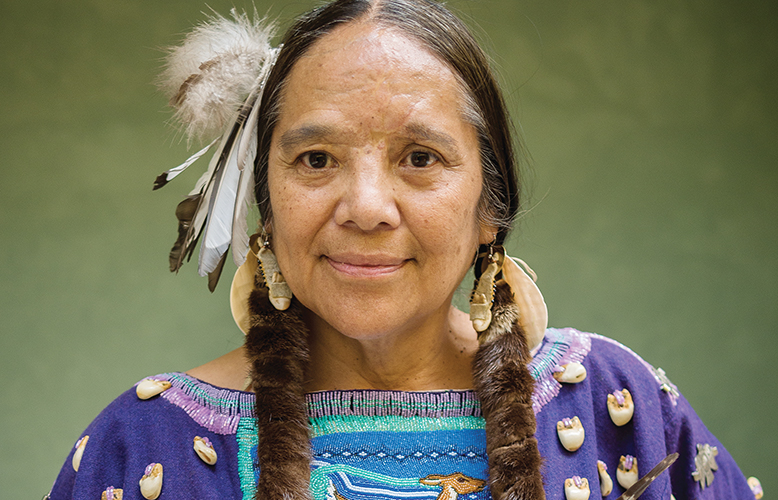(Photo courtesy of Museum at Warm Springs)
A Quarter Century of Culture, History & Community
Museum Description and History
On March 14, 1993, The Museum at Warm Springs opened its doors as a living repository and center to perpetuate the culture and heritage of the Confederated Tribes of Warm Springs. Its mission is to preserve, advance and share knowledge of the cultural, traditional and artistic heritage of The Confederated Tribes of Warm Springs. This year, The Museum will celebrate 25 years as a community treasure and key cultural resource. To mark this milestone, The Museum will present a year-long program of special events and activities, which will be integrated into its regular offerings.
A Vision Comes Alive
The dream of a tribal museum for the Confederated Tribes of the Warm Springs Reservation of Oregon began fifty ago. In 1968, the tribal leadership and community recognized that private collectors or off reservation institutions were buying much of their material culture. Soon thereafter, the Tribes began to allocate $50,000 every year for the purchase of artifacts from individual tribal members and families of the Warm Springs community. The effort represents perhaps the most aggressive acquisition program ever undertaken by an American Indian group. The collection includes family heirlooms, trade items from other tribes, bestowed gifts and keepsakes that have been passed on from generation to generation making the collection one of the best and most complete material collections owned by an Indian tribe. In addition to artifacts, The Museum’s collection boasts 5,000 photographs dating from the 1850’s to the present. The third component of the collection consists of important tribal documents and many books on a wide range of subjects on American Indian history, art and culture.
The support of the Warm Springs community and the commitment behind The Museum are the hallmarks of the project. After 20 years of preparation, the Tribes began focused planning for The Museum in 1987 with the hiring of the first Executive Director. In October 1988, tribal members voted to appropriate $2.5 million for Museum construction. The Tribes then added over $726,498 making their total contribution $3,226,493. In the fall of 1988, the Tribes raised an additional $3.1 million from foundations, corporations and individuals for the construction, education program and museum endowment. The total project costs were $7,728,900. The Museum is the first tribal museum in the state of Oregon. Stastny & Burke Architecture of Portland, Oregon designed the building and the permanent exhibit was designed by Formations, Inc., also of Portland. Construction began May 7, 1992 by S.M. Andersen Construction, Inc. of Portland. The grand opening celebration for the general public was March 14, 1993.
Dr. Duane King, Executive Director, 1987-1990
Michael Templeton, Interim Director, 1990 – 1991
Michael Hammond, Executive Director, 1991-2001
Carol Leone, Executive Director, 2002 – Present
The 25th Anniversary Goals
The Museum will take advantage of this milestone year to create a deeper understanding about Tribal history, culture and heritage, and the Treaty that established the Warm Springs Reservation. We will
recognize individuals whose contributions have been critical to the success of The Museum and the perpetuation of Tribal culture and heritage. We will celebrate 25 years of meaningful museum programs and exhibits.
The summer exhibition, “Memory of the Land: The Treaty of the Middle Columbia River Tribes and Bands” will feature the 1855 Treaty. The exhibition will and explore the history of the Treaty, its impacts today and into the future. The Museum at Warm Springs exhibit will include educational panels and activities to educate the public about the importance of the US Treaties with Indigenous Nations. Sovereignty is the least understood aspect of the treaty negotiations, and treaties with American Indian Tribes are the Supreme Law of the Land.
The Museum will offer a Treaty Symposium on October 25-26, 27 at Kah-Nee-Ta Resort. The Symposium will: focus on education of Tribal children and citizens as to their inheritance of Treaty rights and responsibilities; provide a succinct history of Treaties and of Oregon Tribes; provide ongoing and critical workshops for administrators of Oregon’s County and State Government, and Federal Administrators of the Pacific Northwest region; and assist teachers and educators of Oregon to understand Treaties and history of Oregon Tribes for the mandate of teaching American Indian history in schools; provide essential education for the all-present and future citizens of Oregon regarding Tribal Sovereignty and co-management of Natural Resources. The symposium begins the work of building understanding and connecting people in a network to continue their work with a foundation of appropriate information on which to build both conversation and curriculum.
In the morning, there will be other types of culturally rich and enjoyable activities that can include short field trips, and site visits of cultural significance. In the afternoon there will be the educational panels and workshops. The final day will include sharing from the Confederated Tribes of Oregon to the participants in gratitude for willingness to learn about a key relationship between one of the senior governments of Oregon and county, state and federal governments.

